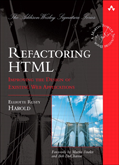HTML Tip #1: Subjects in Mailto Links
Tuesday, May 9th, 2006This tip is dedicated to all the W3C working groups that keep writing things like “you may send your comments to the W3C XSLT/XPath/XQuery mailing list, public-qt-comments@w3.org. It will be very helpful if you include the string [UPD] in the subject line of your comment, whether made in Bugzilla or in email” in their drafts. I’ve gotten tired of making the following suggestion to each and every working group, so let me publish it here publicly for all to see.
It is easy to code a mailto link such that the subject line you’d like correspondents to use appeard automatically in their mail client. That way they don’t have to waste time typing it, and you don’t get so many messages where the correspondent forgets to put the magic keyword in the subject line. Here’s how:
(more…)
